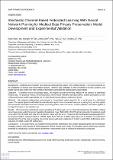| dc.contributor.author | Shao, Rulin | |
| dc.contributor.author | He, Hongyu | |
| dc.contributor.author | Chen, Ziwei | |
| dc.contributor.author | Liu, Hui | |
| dc.contributor.author | Liu, Dianbo | |
| dc.date.accessioned | 2021-10-26T15:46:23Z | |
| dc.date.available | 2021-10-26T15:46:23Z | |
| dc.date.issued | 2020-12 | |
| dc.identifier.issn | 2561-326X | |
| dc.identifier.uri | https://hdl.handle.net/1721.1/133129 | |
| dc.description.abstract | Background: Artificial neural networks have achieved unprecedented success in the medical domain. This success depends on the availability of massive and representative datasets. However, data collection is often prevented by privacy concerns, and people want to take control over their sensitive information during both the training and using processes. Objective: To address security and privacy issues, we propose a privacy-preserving method for the analysis of distributed medical data. The proposed method, termed stochastic channel-based federated learning (SCBFL), enables participants to train a high-performance model cooperatively and in a distributed manner without sharing their inputs. Methods: We designed, implemented, and evaluated a channel-based update algorithm for a central server in a distributed system. The update algorithm will select the channels with regard to the most active features in a training loop, and then upload them as learned information from local datasets. A pruning process, which serves as a model accelerator, was further applied to the algorithm based on the validation set. Results: We constructed a distributed system consisting of 5 clients and 1 server. Our trials showed that the SCBFL method can achieve an area under the receiver operating characteristic curve (AUC-ROC) of 0.9776 and an area under the precision-recall curve (AUC-PR) of 0.9695 with only 10% of channels shared with the server. Compared with the federated averaging algorithm, the proposed SCBFL method achieved a 0.05388 higher AUC-ROC and 0.09695 higher AUC-PR. In addition, our experiment showed that 57% of the time is saved by the pruning process with only a reduction of 0.0047 in AUC-ROC performance and a reduction of 0.0068 in AUC-PR performance. Conclusions: In this experiment, our model demonstrated better performance and a higher saturating speed than the federated averaging method, which reveals all of the parameters of local models to the server. The saturation rate of performance could be promoted by introducing a pruning process and further improvement could be achieved by tuning the pruning rate. | en_US |
| dc.language.iso | en | |
| dc.publisher | JMIR Publications Inc. | en_US |
| dc.relation.isversionof | http://dx.doi.org/10.2196/17265 | en_US |
| dc.rights | Creative Commons Attribution 4.0 International license | en_US |
| dc.rights.uri | https://creativecommons.org/licenses/by/4.0/ | en_US |
| dc.source | JMIR Publications | en_US |
| dc.title | Stochastic Channel-Based Federated Learning With Neural Network Pruning for Medical Data Privacy Preservation: Model Development and Experimental Validation | en_US |
| dc.type | Article | en_US |
| dc.identifier.citation | Shao Rulin et al. "Stochastic Channel-Based Federated Learning With Neural Network Pruning for Medical Data Privacy Preservation: Model Development and Experimental Validation." JMIR Formative Research 4, 12 (December 2020): e17265. © 2020 Shao, Rulin et al. | en_US |
| dc.contributor.department | Massachusetts Institute of Technology. Computer Science and Artificial Intelligence Laboratory | en_US |
| dc.relation.journal | JMIR Formative Research | en_US |
| dc.eprint.version | Final published version | en_US |
| dc.type.uri | http://purl.org/eprint/type/JournalArticle | en_US |
| eprint.status | http://purl.org/eprint/status/PeerReviewed | en_US |
| dc.date.updated | 2021-10-26T12:53:29Z | |
| dspace.orderedauthors | Shao, R; He, H; Chen, Z; Liu, H; Liu, D | en_US |
| dspace.date.submission | 2021-10-26T12:53:35Z | |
| mit.journal.volume | 4 | en_US |
| mit.journal.issue | 12 | en_US |
| mit.license | PUBLISHER_CC | |
| mit.metadata.status | Complete | en_US |
